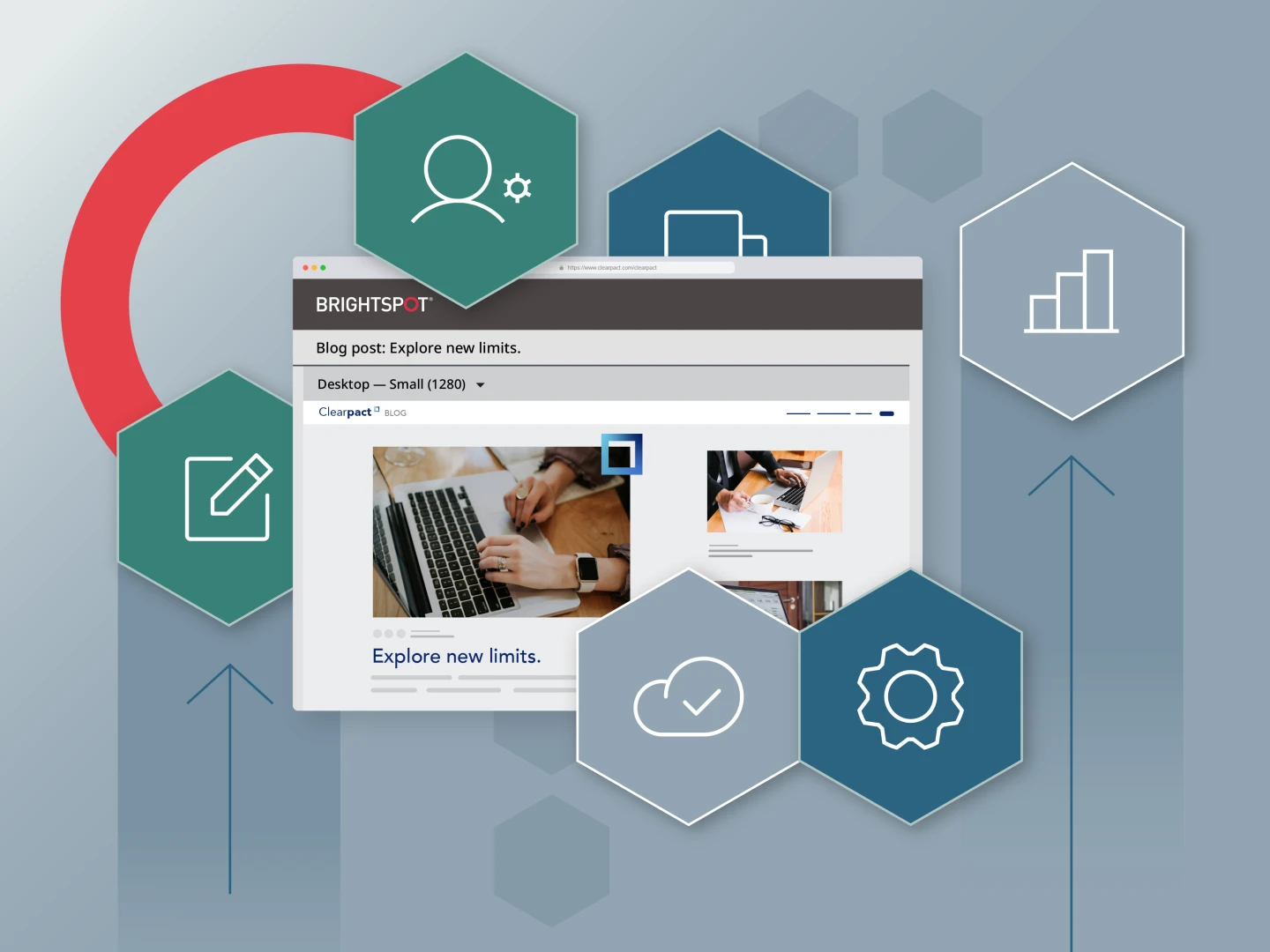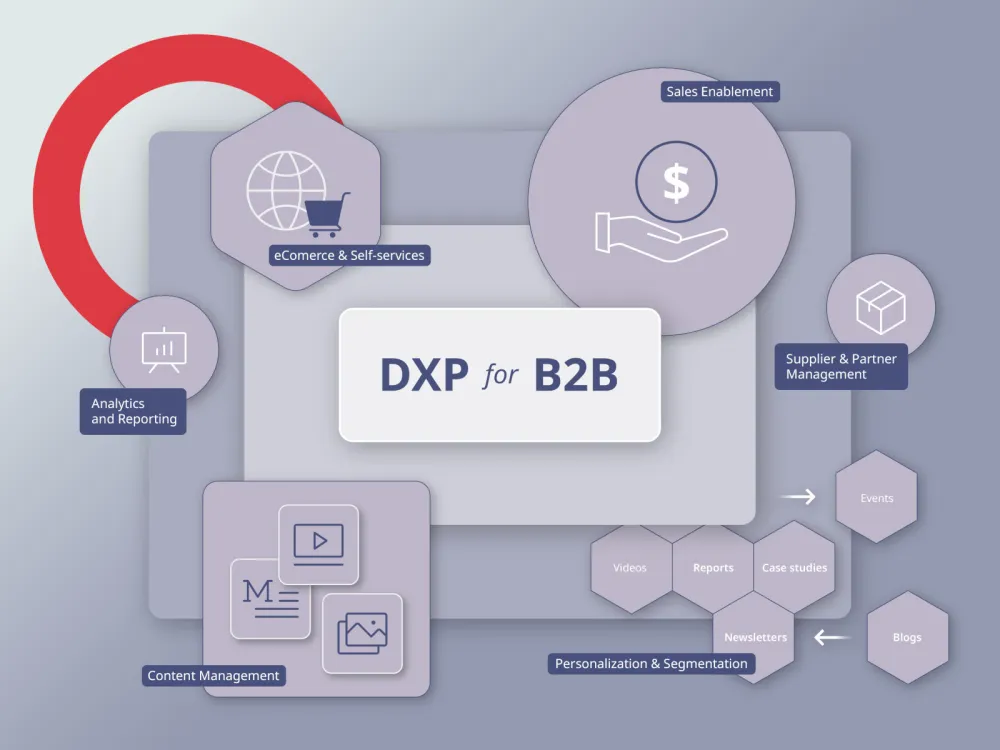A digital experience platform (DXP) is a software solution that helps businesses create and manage engaging digital experiences for their customers.
It combines several different tools and capabilities, including content management, customer data management, digital asset management, marketing automation, analytics, personalization and even artificial intelligence, into a single platform.
While it’s certainly possible to have these capabilities built into one standalone tool, a composable DXP takes a modular approach. This gives businesses the flexibility to choose and integrate only the specific tools and capabilities they need, rather than being locked into a one-size-fits-all solution.
What is a composable DXP?
A composable DXP is a type of digital experience platform that allows organizations to assemble and manage a customized suite of digital marketing tools and applications. These business capabilities are interconnected via APIs and leverages a microservices architecture, meaning they can be easily added, removed or replaced depending on the organization’s needs.
Every component of a composable digital experience platform is a cloud-native SaaS, meaning users can access and manage it from any compatible device with an internet connection. It’s built on top of a core platform (like a CMS) that serves as the foundation for all other tools and capabilities.
Taking a modular approach to DXP enables organizations to create a flexible and agile digital ecosystem that can easily adapt to changing market trends, technologies and customer expectations.
What makes a composable DXP different?
Traditional (monolithic) DXPs offer an all-in-one solution, bundling multiple capabilities into one platform. While this may seem convenient at first, it creates a rigid and inflexible system that can be challenging to scale or adapt.
Unlike monolithic DXPs, which come with pre-defined features and capabilities, a composable DXP offers a flexible and adaptable solution. Modular components allow businesses to quickly add or remove tools as needed without disrupting the entire system. And they can scale up or down as business needs change, for an agile and personalized approach to managing their digital presence.
Since they’re extensible to multiple platforms and channels, composable DXPs also prevent lock-in by a single software vendor. And they eliminate the need to continually invest in costly legacy systems or overhaul their entire tech stack to scale or keep up with evolving technology and customer expectations.
What do the best composable DXPs include?
The best composable DXP solutions are built around flexibility, scalability and a modular approach to technology. Here are key components they typically include:
- Headless/hybrid CMS: A headless content management system allows for content to be created, stored, and managed independently from the front-end delivery, enabling seamless distribution across various channels like websites, mobile apps and IoT devices. Brightspot goes a step further here with its hybrid-headless capabilities, meaning brands are not locked into one singular architectural approach.
- Customer Data Platform (CDP): A robust CDP enables organizations to collect, unify and manage customer data in real time. This data is critical for delivering personalized experiences and tailoring content and offers based on user behavior and preferences.
- Personalization engine: A personalization engine uses the data collected by the CDP to deliver tailored content, product recommendations and customer journeys. It’s essential for optimizing the customer experience across different touchpoints.
- API-first integration: The core of a composable DXP is the ability to easily integrate various best-of-breed tools through APIs. This ensures businesses can assemble a tech stack that meets their unique needs and easily swap out tools as requirements evolve.
- Analytics and reporting tools: Advanced analytics and reporting capabilities are critical for tracking customer behavior, engagement, and performance. The best composable DXPs offer robust data visualization and reporting tools to optimize experiences in real time.
- Omnichannel delivery: A composable DXP supports content and experience delivery across a wide range of digital touchpoints, from web and mobile to social media and wearable devices. This ensures consistent, cohesive customer experiences, regardless of where the engagement happens.
- Scalability and flexibility: The best composable DXPs are highly scalable, allowing businesses to grow and adapt quickly without being locked into a rigid platform. This flexibility ensures that organizations can innovate faster, respond to market changes and integrate new technologies as needed.
Benefits of composable DXPs like Adobe, Sitecore DXP & Brightspot
A monolithic DXP might be an OK starting point if you’re a small business or are completely new to digital marketing. But it almost certainly won’t evolve with your business. Eventually, it’ll hold you back.
On the contrary, composable DXPs offer tremendous benefits:
- A best-of-breed approach you can tailor to your specific needs and use to fill in the gaps other tools can’t
- Easy integration with existing systems, enabling you to build on top of your current marketing stack
- Faster time to value with plug-and-play functionality, off-the-shelf components and faster integration and implementation times
- Personalized, contextualized experiences with the help ofmachine learning and artificial intelligence
- No vendor lock-in and a more agile system that can scale and adapt to your evolving needs
- Cost efficiency, since you’re only paying for modules you’re actively using (vs. a monolith that includes functionalities you might never touch)
- Future-proofed strategy, as SaaS components are continually updated and improved, enabling you to keep up with the latest trends and technology
Technology freedom, the ability to offer customer-centric omnichannel experiences and the flexibility to adapt and evolve. It’s hard to argue with that.
Essential components of a composable DXP digital platform
As mentioned, a composable DXP allows organizations to choose and integrate only the specific tools they need. Businesses can create a tailored digital experience for their audience, rather than being limited by pre-defined capabilities. That said, there are a few key components that every composable DXPs will incorporate.
Let’s dive in.
DXP tech stack feature 1: Content management
A content management system (CMS) is at the core of every DXP, including composable ones. Composable DXPs like Brightspot combine headless and traditional CMS capabilities to create, store, and distribute content to various channels and devices in real-time.
Within hybrid architecture...
- Headless CMS focuses on content creation and management, rather than presentation. It separates content from its presentation layer, allowing businesses to deliver consistent and personalized experiences across channels.
- Decoupled CMS fills the role of a presentation layer, providing a user-friendly interface for content creation and management. It also handles templating and page design.
Headless CMS ensures your developers have the freedom to innovate and build custom solutions without compromising brand consistency or user experience. A decoupled CMS empowers content creators to work efficiently by utilizing templates and visual editors in familiar, easy-to-use backend environments.
DXP tech stack feature 2: Contextual intelligence and relevance
DXPs built on a microservices and API-first infrastructure have a significant advantage in personalization. Data from all components is aggregated and stored in a centralized location, allowing businesses to create personalized customer journeys and offer contextually relevant experiences.
A customer profile engine creates a single view of the customer, including their interactions with your brand across various touchpoints. You can use this information to create tailored experiences and offers, and present them to the right users at the right time.
Additional features, like language translation and voice search (which nearly half of U.S. adults use daily) further improve the overall user experience and drive engagement.
DXP tech stack feature 3: E-commerce
Where a composable DXP really outshines traditional CMS is in its e-commerce module. Within a composable DXP, you can:
- Manage your product catalog
- Host a digital storefront
- Create a shopping cart/checkout funnel
- Use individual personalization to display recommended products and offers
- Integrate with payment gateways
- Manage orders and shipping
- Provide customer self-service portals
Depending on the platform you use, you can also integrate your DXP with 3PL systems, warehouse management and inventory software, or ERP to streamline your backend operations.
DXP tech stack feature 4: Digital asset management
Digital asset management enables brands to store, organize and manage their digital assets (i.e., images, videos, documents) in a centralized location. The DAM module of a composable DXP ensures you have full access to your assets within the CMS and can easily use them in your content.
The Brightspot DAM module incorporates advanced search capabilities like exact-phrase search and filtering by metadata. It also uses intelligent image and video analysis to automatically tag and categorize assets based on people, objects, text and actions.
DXP tech stack feature 5: Customer engagement
90% of customers rate immediate responses as “important” when they have a question. Whether they’re choosing between two options, need help finding the right product, wondering where their package is, or have a technical issue, responding slowly is the fastest way to leave them (and earn a bad review).
Depending on your particular setup, you might include chatbots, marketing automation, mobile apps, customer portals and other engagement features within your DXPs digital toolbox.
DXP tech stack feature 6: Predictive analytics and machine learning
Advanced composable DXPs (including Brightspot) will come with analytics and AI capabilities out-of-the-box. You can use this information to identify customer trends, fine-tune personalization strategies, create targeted content, adjust campaign approaches and more.
Examples of how DXPs can use machine learning include:
- Offering personalized product recommendations to individual customers based on their previous interactions and purchase history
- Using natural language processing to automatically tag and categorize content for faster search and retrieval
- Automatically identifying similar content or outdated pieces that need updating or retiring
DXP tech stack feature 5: Customer data platform (CDP)
Composable DXPs enable both customers and employees to interact across various channels through client UI technologies like HTML/CSS, JavaScript, JSON, GraphQL and OData, which are used to build responsive and interactive interfaces.
Every instance of interaction, request routing and application logging data is collected and saved to the data layer to create an individual profile. This data can then be used to create highly personalized experiences for each customer, both automatically (through tailored offers and digital experiences) and with manual input (from customer service agents or sales reps).
A digital experience platform (DXP) is a software framework designed to enable businesses to create, manage and deliver personalized customer experiences across various digital touchpoints. DXPs centralize content, marketing, and data management to provide seamless customer interactions. The focus is on delivering a cohesive experience that spans websites, mobile apps, social media and other digital channels.
A monolithic DXP is an all-in-one solution that bundles content management, analytics, personalization and other features into a single platform. While this approach offers simplicity, it can limit flexibility and scalability. A composable DXP, by contrast, allows businesses to select and integrate individual components — such as content management systems (CMS), customer data platforms (CDP) and marketing automation tools — based on their specific needs. This modular approach enables organizations to tailor their tech stack, innovate faster and adapt more easily to changing market conditions.
A DXP platform is the foundation that supports an organization’s digital experience strategy. It consists of a set of integrated technologies that allow businesses to manage content, orchestrate customer journeys and deliver personalized experiences. DXP platforms often include tools for content management, analytics, personalization and omnichannel delivery. A composable DXP architecture takes this further by allowing businesses to customize their platform with best-of-breed solutions to meet specific goals.
Build your composable DXP with Brightspot at the center
Interoperability is the most important feature of any composable DXP. If your core system won’t work with the rest of your marketing stack, you don’t have a composable DXP (or any real integrated platform, for that matter).
Brightspot is built around the core tenets of interoperability and extensibility. It’s API-first and can even serve as a “second CMS” if you’re already using a solution like Adobe AEM for digital experience management.
See how Brightspot’s composable DXP fits into your marketing stack by booking a demo.










